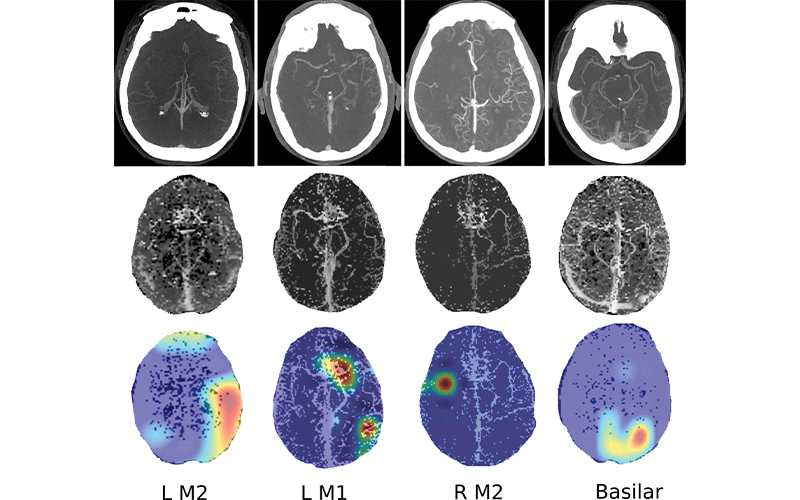Deep Learning Model Provides Rapid Detection of Stroke-causing Blockages
Model can reduce time to treatment for ischemic strokes
Deep learning (DL) can help rapidly detect blockages in the arteries that supply blood to the head, potentially speeding the onset of life-saving treatment, according to a study in Radiology.
Prompt diagnosis is critical in order to begin recanalization through endovascular therapy.
“Minutes matter in this time-sensitive diagnosis,” said study lead author Matthew T. Stib, MD, a radiology resident at the Warren Alpert Medical School at Brown University, Providence, RI. “Every minute that we reduce the time to recanalization extends the patient’s disability-free life by a week.”
CT angiography (CTA) is the gold standard for detecting these occlusions. Radiologists are highly accurate at identifying large vessel occlusions on CTA, but they are not always available, and any backlogs at the hospital can further delay care.
Dr. Stib and his colleagues at Brown explored the use of DL to help provide rapid detection of large vessel occlusions on CTA and reduce time to treatment.

Images show four separate patients with large vessel occlusions correctly predicted by the algorithm. The top row shows a representative CT slice from the delayed venous phase CT angiography. The middle row shows the preprocessed maximum intensity projection images that function as the input to the model. The bottom row are overlaid heat maps, with areas in red showing the most discriminative regions. Notice these so-called hot regions correlate with the occlusion location (respectively: left [L] M2, L M1, right [R] M2, basilar) in each patient.
Deep Learning Model Has Higher Sensitivity Rate Than CTA
Working closely with Brown’s computer science department, the researchers developed a DL model from scratch. They used a large sample of CTA examinations for patients with suspected acute ischemic stroke to train the algorithm to recognize the appearance of large vessel occlusions and distinguish it from other conditions. Preprocessing of the CTA exams included the creation of maximum intensity projection images to emphasize the contrast-enhanced vasculature. The researchers also used multiphase CTA, a newer approach that provides more comprehensive information than the single-phase technique.
When they tested the DL model on multiphase CTA examinations of 62 patients, the model detected all 31 large vessel occlusions for a sensitivity of 100%, a statistically significant improvement over the 77% sensitivity rate of single-phase CTA. The use of multiphase CTA contributed to the improved performance.
“These results are quite promising,” Dr. Stib said. “We really wanted to optimize the sensitivity of the model so that we were sure that we picked up every single case because missing a case has pretty dire consequences.”
The study is the first to use multiphase CTA to look at occlusions in both the arteries of the anterior and posterior parts of the head and neck.
“Posterior circulation occlusions have not been discussed much in machine learning literature,” Dr. Stib said. “They’re less common but have pretty profound clinical consequences if missed. It’s important to have an algorithm that detects all categories of occlusion, both anterior and posterior.”
The next step in the research is to validate the results using the algorithm in real time and see if it can improve outcomes for patients. If the results hold up, then the DL model could be a useful asset in medical centers or hospitals that don’t have the expertise for reading large vessel occlusion CTA images.
“This algorithm is not replacing the ability of radiologists to do their job; rather, it’s trying to speed up the time to diagnosis,” Dr. Stib said. “So if the radiologist isn’t around or there is a large workflow that is preventing someone from looking at the exam results quickly, there will be an alert that says an occlusion may be present and someone should look at this. That’s where the value is in this kind of a model.”
The team worked under the direction of the study’s senior author Ryan A. McTaggart, MD, a neuroradiologist specializing in interventional neuroradiology at Rhode Island Hospital, Providence, and proponent of decreasing the time to treatment for large vessel occlusions.
For More Information
Access the Radiology study, “Detecting Large Vessel Occlusion at Multiphase CT Angiography by Using a Deep Convolutional Neural Network.”